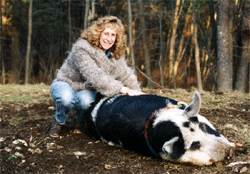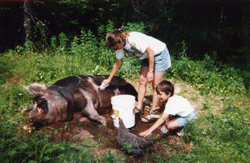The Good Good Pig
Air Date: Week of June 9, 2006

Sy Montgomery with Chris as a young adult resting on the Pig Plateau and enjoying a belly rub. (Photo: Ian Redmund)
Living on Earth’s commentator, Sy Montgomery’s famous pig, Christopher Hogwood, has passed on. But he left his owner with enough fond memories to write a book. And that’s just what she did. Sy Montgomery joins us to talk about her most recent book, The Good Good Pig.
Transcript
CURWOOD: There’s nothing quite like the sound of a happy pig. This recording was taken several years ago atop the Pig Plateau, a wooded clearing in southern New Hampshire where a certain pig by the name of Christopher Hogwood would hold court, feasting on all manner of delicacies and slops. It was a charmed life, to say the least.
Christopher has since gone to hog heaven. And his owner, Living on Earth commentator Sy Montgomery, has written a memoir of all his misadventures. She joins me now with her new book, “The Good Good Pig: The Extraordinary Life of Christopher Hogwood.” And what a life it was! But Sy, maybe you should start from the beginning and tell us all, who exactly was Christopher Hogwood?
MONTGOMERY: Well Christopher Hogwood still actually is a famous conductor after whom we named a runty spotted pig who we adopted when he was so little he fit in a shoebox. He was a runt half the size of all the other runts at this piggery, in the year 1990. It was a very bad year for this poor little pig, because it’s hard enough being a runt, but being a runt half the size of the other runts he really had almost no chance of surviving. And he had every kind of disease possible. It was like George Burns on “The Simpsons,” you know?
Anyway, this pig was so sick and so runty that the people who own the piggery, who are friends of my husband and I, when I was in Virginia caring for my sick father, who was dying of cancer, they called my husband and said ‘How’d you like having a runt pig move in with you?’ And Howard said ‘normally I wouldn’t even tell her that you called, but her father’s dying, it’s a very hard time for her, and I think she’d really be cheered up by a sickly little pig.’ And so that’s how he came home to us.

Sy Montgomery with Chris as a young adult resting on the Pig Plateau and enjoying a belly rub. (Photo: Ian Redmund)
MONTGOMERY: Yes, and I’ve got to show you the very best part of it. If you take the paper cover off you’ll notice in the lower right-hand corner is a snout print embossed onto the cover. And I swear that’s exactly what Christopher would have done. Because he left his snout print on almost everything.
CURWOOD: Now this snout print, as you call it, is about the size of a quarter. Christopher Hogwood was on the, shall I say, large size.
MONTGOMERY: Yes. After he came home in a shoe box he grew to an enormous size nobody expected. He eventually got to be 750 pounds. And he lived to the very ripe old age of 14, and most pigs live to be six months. Of course, that’s because they quickly turn into bacon or salami or something like that. But because I’m a vegetarian and my husband is Jewish, that was not going to be his fate.
CURWOOD: (Laughs) A Kosher pig.
MONTGOMERY: Yes, he was.
CURWOOD: And if he got to 750 pounds, did you have to put him on a diet?

What is beer but liquid grain? Christopher enjoys a Schlitz. (Photo: Sy Montgomery)
And this was dreadful, because he was getting food from all over the place. People used to save their slops in the freezer for him and drive it in from other parts of the country. Some people actually mailed him slop. And we used to pick up these wonderful gourmet slops from Fiddlehead’s Café. We would lift the lid of the slops and out would waft the scent of balsamic vinegar and lovely delicate marinades and imported olives…
CURWOOD: Oh my gosh, this pig was eating out every night!
MONTGOMERY: Yes he was. And when we would go to some event in town, you know, a wedding or a reception or something, it was usually catered by Fiddlehead’s, and we’d find that we were eating the same stuff the pig was. But the presentation, of course, was different.
CURWOOD: (Laughs) Now, in some ways Christopher was something of an experiment, wasn’t he?
MONTGOMERY: Well we were really pushing the boundaries of porcine knowledge. No one really knew how long pigs lived. And we certainly didn’t know how big he’d get. We thought he might stay small. We were told by the folks who owned the piggery that there was a good chance that he would stay small, but the miracle of a swine warmer combined with Schlitz beer, which was one of his favorite things to drink, just – he grew very quickly. And so did his circle of friends.
CURWOOD: Along the lines of an experiment, so just how did your pig behave, you know, a little bit tight with all this beer?
MONTGOMERY: Ah! Well, we never got him drunk. I mean, he was just so big you couldn’t give him enough. He just loved the taste. But then he loved the taste of many things. And he had good taste in music, too, Steve. Pigs actually have quite a refined sense of many of the great fine things in life. They really can be quite sensitive, quite delicate. They’re very emotional creatures, and very kind at heart. They have a great sense of humor, Chris certainly did, and he was a sensitive soul.
CURWOOD: And a smart soul at that.
MONTGOMERY: Yes. Pigs are incredibly smart. Very few people realize that. But they’re so smart that in past centuries people who couldn’t afford hunting dogs used hunting pigs, and they would act like pointers. Quite a number of researchers have tested pigs’ intelligence, and they generally come out smarter than dogs. But my husband and I think that they actually – at least Chris did – come out smarter than us, because he got to have two college-educated people working full time for him for free.
CURWOOD: (Laughs) Eating the best food in town!
MONTGOMERY: That’s right.
CURWOOD: Now of course your book is not just about your relationship with Christopher Hogwood, your pig, but it’s about your life and your relationships and what’s going on in your family, particularly with your mom and dad. How did this pig, Christopher, influence those relationships?
MONTGOMERY: Well, when Chris came into my life my father was dying, my family was pretty much in shatters. I was an only child, and my parents had disowned me because they didn’t like who I married. And I married the greatest guy, but he was Jewish, and my mother was raised Methodist and she didn’t like that at all. So this book is really a book about family. I built another family when my family disowned me. And it was a multi-species household and it included people who weren’t genetically related to me, lots of kids who weren’t genetically related to me.

Antioch biology professor Beth Kaplan and her daughter Stella at Pig Spa. (Photo: Sy Montgomery)
MONTGOMERY: (Laughs) Well, first of all he was like our ambassador of the barnyard. I don’t know. I mean, I’m really kind of a shy person. Chris introduced me to my neighborhood. How? By busting out and running down the street and getting rescued by people who I hardly knew. We’d only been living there for a few years by the time Christopher came into our lives. But boy, I’ll tell ya, there’s nothing that’s going to get you to know your neighbors faster than a black and white spotted pig rooting up their lawn. So he introduced me to a lot of people in that way.
He also introduced me to children. When I was growing up, as I was a child I didn’t have friends who were children. I didn’t get along with other children for various reasons. But once I got Chris I had more friends who were children than I had in my entire childhood.
CURWOOD: What’s your favorite story about Christopher Hogwood?
MONTGOMERY: Oh, wow. Well, I just loved the performance art that he did of eating. And I loved how much he meant to people. And when he finally died, I’d never seen such an outpouring from people. And remember, he outlived my mother and my father, so I had been to funerals of people that I loved and people were very generous and kind to us. But when the pig died, the house was so full of flowers we filled up every single vase and every single pickle jar. We got cards and letters and phone calls and emails. People brought food, just like they do when a person died.
And some stories about him I found out after he died, of why he meant so much to so many people. And that ‘why’ was all over the place. In some cases people just loved the idea of Yankee thrift, that you could bring your garbage and he would eat it. In some cases people just loved him when he was tiny and he was so adorable and then he was so huge, he was so much fun.
But in other cases people told me stories, really heart-wrenching stories, of how Chris kind of completed a sad story and made it better. Or how Chris kind of redeemed a pig that one person had once had who she loved very much but who got shot, essentially by mistake by the butcher. Another person told me the story of why his wife loved the pig so much. And it was because she had been an orphan with a terrible childhood, and Chris had been an orphan too. But his childhood had been a wonderful, charmed childhood, and she loved him to bits because it was like her story rewritten and come out right.
CURWOOD: Sy Montgomery is the author of “The Good, Good Pig: The Extraordinary Life of Christopher Hogwood.” Thanks so much, Sy.
MONTGOMERY: Thank you, Steve.
Links
Living on Earth wants to hear from you!
Living on Earth
62 Calef Highway, Suite 212
Lee, NH 03861
Telephone: 617-287-4121
E-mail: comments@loe.org
Newsletter [Click here]
Donate to Living on Earth!
Living on Earth is an independent media program and relies entirely on contributions from listeners and institutions supporting public service. Please donate now to preserve an independent environmental voice.
NewsletterLiving on Earth offers a weekly delivery of the show's rundown to your mailbox. Sign up for our newsletter today!
 Sailors For The Sea: Be the change you want to sea.
Sailors For The Sea: Be the change you want to sea.
 The Grantham Foundation for the Protection of the Environment: Committed to protecting and improving the health of the global environment.
The Grantham Foundation for the Protection of the Environment: Committed to protecting and improving the health of the global environment.
 Contribute to Living on Earth and receive, as our gift to you, an archival print of one of Mark Seth Lender's extraordinary wildlife photographs. Follow the link to see Mark's current collection of photographs.
Contribute to Living on Earth and receive, as our gift to you, an archival print of one of Mark Seth Lender's extraordinary wildlife photographs. Follow the link to see Mark's current collection of photographs.
 Buy a signed copy of Mark Seth Lender's book Smeagull the Seagull & support Living on Earth
Buy a signed copy of Mark Seth Lender's book Smeagull the Seagull & support Living on Earth

